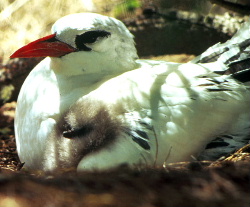Tropicbird
|
|
| Tropicbirds | ||||||||||||
|---|---|---|---|---|---|---|---|---|---|---|---|---|
 Red-tailed Tropicbird | ||||||||||||
| Scientific classification | ||||||||||||
| ||||||||||||
| Species | ||||||||||||
|
P. aetherius |
The three tropicbirds are closely related seabirds of tropical oceans. They are slender white birds with exceptionally long central tail feathers. Their long wings have black markings, as does the head.
They breed on tropical islands laying a single egg directly onto the ground or a cliff ledge. They feed on fish and squid, but are poor swimmers.
The Red-billed Tropicbird occurs in the tropical Atlantic, eastern Pacific, and Indian oceans. The Indian Ocean subspecies of Red-billed tropicbird P. a. indicus was at one time considered a full species, the Lesser Red-billed Tropicbird.
The Red-tailed Tropicbird occurs in the Indian Ocean and the western and central tropical Pacific.
The White-tailed Tropicbird is widespread in tropical waters, except in the eastern Pacific.
This group is related to other Pelecaniformes as below:
Order Pelecaniformes
- Family Pelecanidae - pelicans
- Family Sulidae - gannets and boobies
- Family Phalacrocoracidae - cormorants
- Family Fregatidae - frigatebirds
- Family Anhingidae - Anhinga and darters
- Family Phaethontidae: tropicbirds
- Genus Phaethon
- Red-billed Tropicbird, P. aethereus
- White-tailed Tropicbird, P. lepturus
- Red-tailed Tropicbird, P. rubricauda
- Genus Phaethon
The Sibley-Ahlquist taxonomy gives a radically different scientific arrangement for this group based on DNA studies.da:Tropikfugle nl:Keerkringvogels pl:Faetonowate
